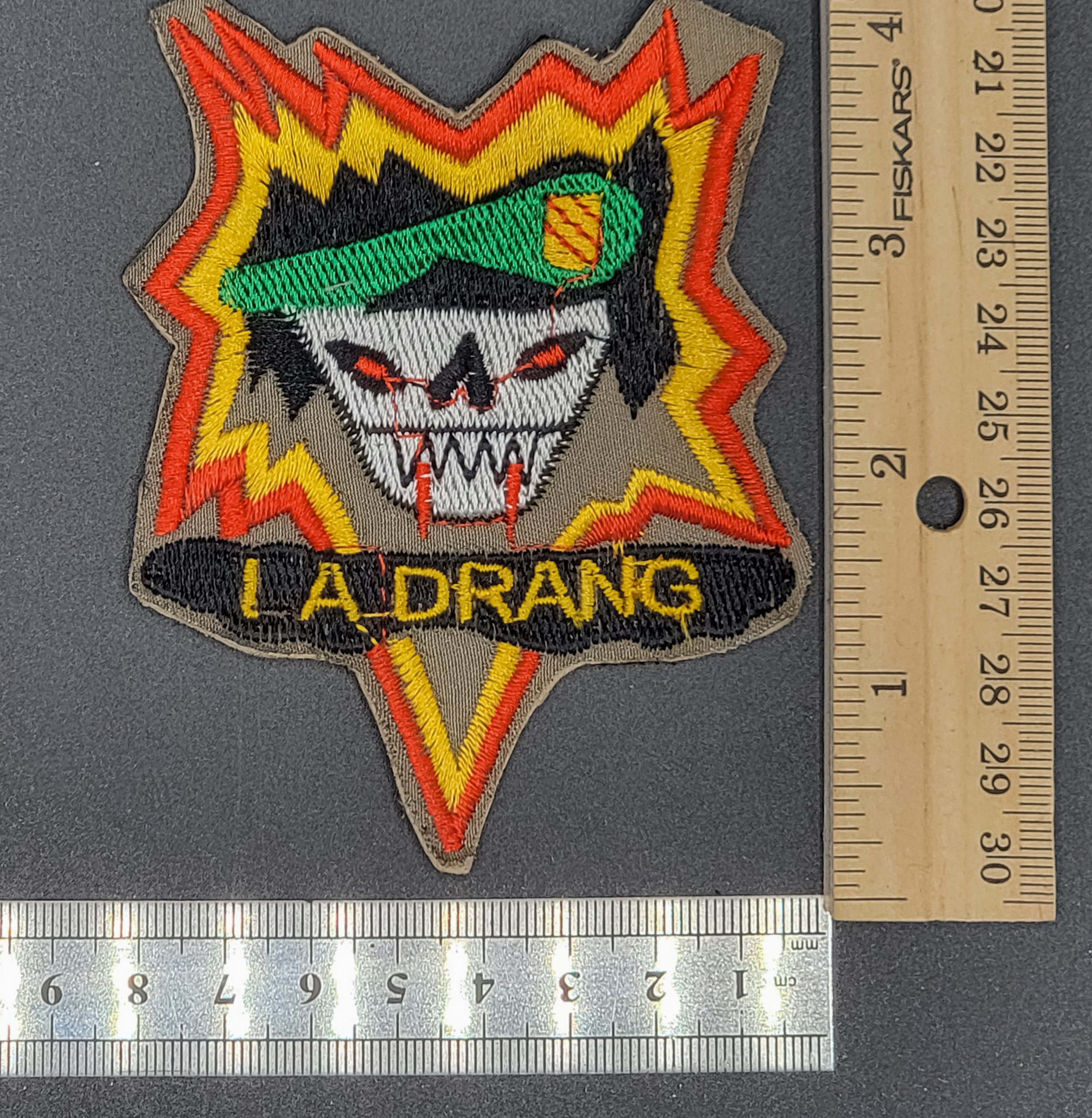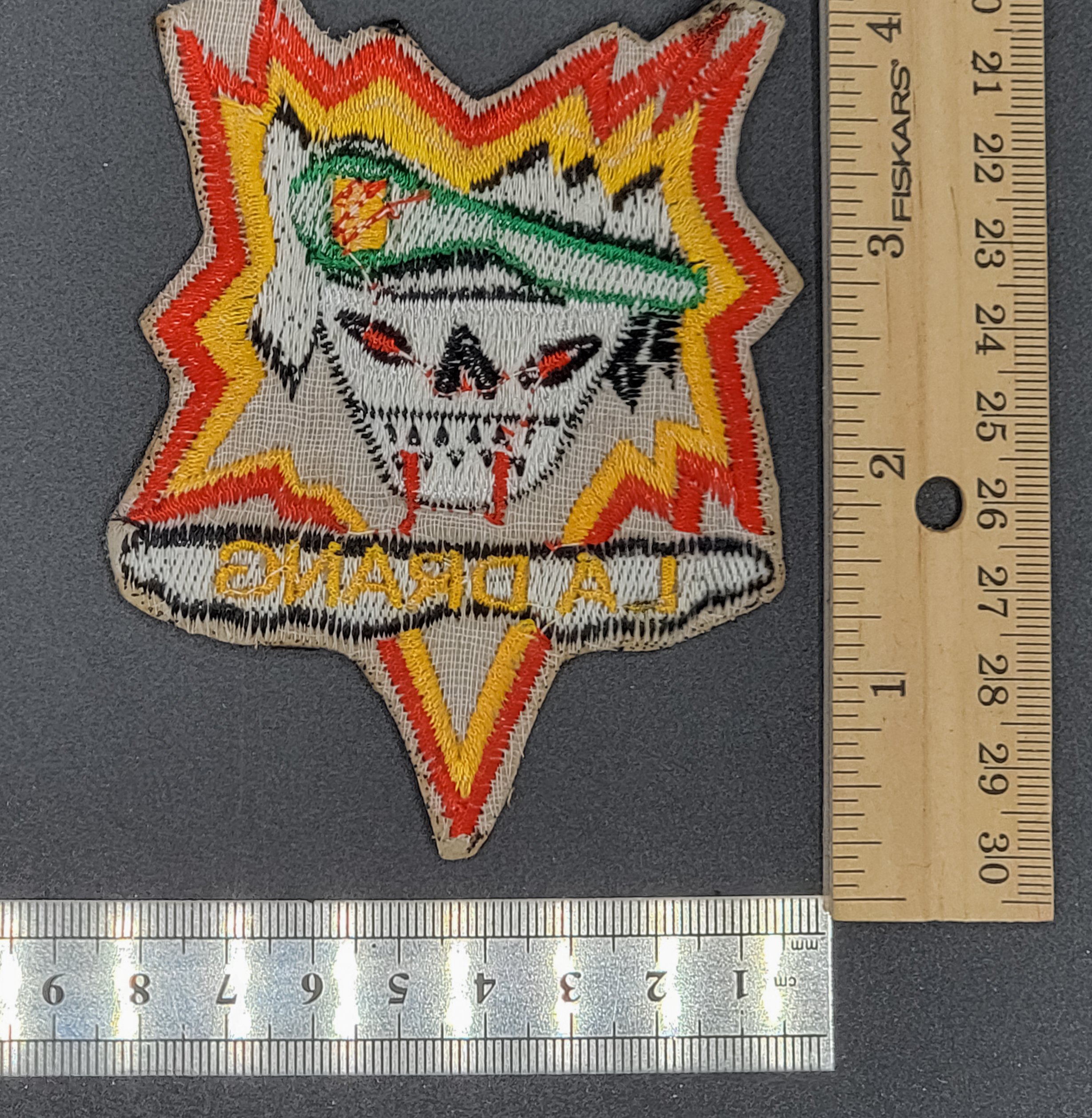BATTLE of IA DRANG VALLEY - Patch - MACV-SOG - Shell Burst - Vietnam War
Vietnam War - Green Berets - US Special Forces - MACV-SOG
Measures - 4 x 3.2 inches (10 x 8 cms)
US Special Forces - Black Ops - Green Berets
Shell Burst Patch - De Oppresso Liber - 1st / 5th Special Forces Group Airborne
Special Operations Association - Airborne Special Forces - Battle of Ia Drang Valley
The U.S. Special Forces played a significant role in the Battle of Ia Drang Valley, which was fought in November 1965. The battle was part of Operation "Silver Bayonet" and is considered one of the first major engagements between U.S. forces and the North Vietnamese Army (NVA).
The U.S. Special Forces units involved in the Battle of Ia Drang Valley were members of the 1st Special Forces Group, also known as the Green Berets. They worked in close coordination with the U.S. Army's 1st Cavalry Division (Airmobile).
The battle took place in the Ia Drang Valley, located in the Central Highlands of South Vietnam near the Cambodian border. The NVA had established bases in the region and intended to lure U.S. forces into a large-scale confrontation. They believed that defeating the Americans would undermine their will to continue fighting in Vietnam.
The U.S. forces, including the Special Forces, were inserted by helicopter into landing zones within the Ia Drang Valley. They faced heavy resistance from the NVA, leading to intense and prolonged battles.
The Special Forces played a crucial role in advising and coordinating with the American units on the ground. They utilized their expertise in unconventional warfare, counterinsurgency tactics, and local intelligence to assist in the planning and execution of operations.
One of the most well-known engagements of the Battle of Ia Drang Valley was the Battle of Landing Zone X-Ray, where U.S. forces, including Special Forces, were surrounded by NVA troops. The U.S. units fought fiercely and managed to repel repeated enemy assaults, thanks in part to the close air support provided by U.S. aircraft.
The Battle of Ia Drang Valley was a significant engagement that showcased the challenges faced by U.S. forces in Vietnam. It highlighted the determination and resilience of both the American and NVA troops, as well as the effectiveness of U.S. air power and the strategic importance of Special Forces expertise in unconventional warfare.
The battle and subsequent operations in the Ia Drang Valley had a profound impact on U.S. military tactics and strategy in Vietnam. It provided valuable lessons for future operations and influenced the development of airmobile tactics, emphasizing the use of helicopters for rapid deployment and mobility in the challenging terrain of Vietnam.
Vietnam War - Green Berets - US Special Forces - MACV-SOG
Measures - 4 x 3.2 inches (10 x 8 cms)
US Special Forces - Black Ops - Green Berets
Shell Burst Patch - De Oppresso Liber - 1st / 5th Special Forces Group Airborne
Special Operations Association - Airborne Special Forces - Battle of Ia Drang Valley
The U.S. Special Forces played a significant role in the Battle of Ia Drang Valley, which was fought in November 1965. The battle was part of Operation "Silver Bayonet" and is considered one of the first major engagements between U.S. forces and the North Vietnamese Army (NVA).
The U.S. Special Forces units involved in the Battle of Ia Drang Valley were members of the 1st Special Forces Group, also known as the Green Berets. They worked in close coordination with the U.S. Army's 1st Cavalry Division (Airmobile).
The battle took place in the Ia Drang Valley, located in the Central Highlands of South Vietnam near the Cambodian border. The NVA had established bases in the region and intended to lure U.S. forces into a large-scale confrontation. They believed that defeating the Americans would undermine their will to continue fighting in Vietnam.
The U.S. forces, including the Special Forces, were inserted by helicopter into landing zones within the Ia Drang Valley. They faced heavy resistance from the NVA, leading to intense and prolonged battles.
The Special Forces played a crucial role in advising and coordinating with the American units on the ground. They utilized their expertise in unconventional warfare, counterinsurgency tactics, and local intelligence to assist in the planning and execution of operations.
One of the most well-known engagements of the Battle of Ia Drang Valley was the Battle of Landing Zone X-Ray, where U.S. forces, including Special Forces, were surrounded by NVA troops. The U.S. units fought fiercely and managed to repel repeated enemy assaults, thanks in part to the close air support provided by U.S. aircraft.
The Battle of Ia Drang Valley was a significant engagement that showcased the challenges faced by U.S. forces in Vietnam. It highlighted the determination and resilience of both the American and NVA troops, as well as the effectiveness of U.S. air power and the strategic importance of Special Forces expertise in unconventional warfare.
The battle and subsequent operations in the Ia Drang Valley had a profound impact on U.S. military tactics and strategy in Vietnam. It provided valuable lessons for future operations and influenced the development of airmobile tactics, emphasizing the use of helicopters for rapid deployment and mobility in the challenging terrain of Vietnam.
Vietnam War - Green Berets - US Special Forces - MACV-SOG
Measures - 4 x 3.2 inches (10 x 8 cms)
US Special Forces - Black Ops - Green Berets
Shell Burst Patch - De Oppresso Liber - 1st / 5th Special Forces Group Airborne
Special Operations Association - Airborne Special Forces - Battle of Ia Drang Valley
The U.S. Special Forces played a significant role in the Battle of Ia Drang Valley, which was fought in November 1965. The battle was part of Operation "Silver Bayonet" and is considered one of the first major engagements between U.S. forces and the North Vietnamese Army (NVA).
The U.S. Special Forces units involved in the Battle of Ia Drang Valley were members of the 1st Special Forces Group, also known as the Green Berets. They worked in close coordination with the U.S. Army's 1st Cavalry Division (Airmobile).
The battle took place in the Ia Drang Valley, located in the Central Highlands of South Vietnam near the Cambodian border. The NVA had established bases in the region and intended to lure U.S. forces into a large-scale confrontation. They believed that defeating the Americans would undermine their will to continue fighting in Vietnam.
The U.S. forces, including the Special Forces, were inserted by helicopter into landing zones within the Ia Drang Valley. They faced heavy resistance from the NVA, leading to intense and prolonged battles.
The Special Forces played a crucial role in advising and coordinating with the American units on the ground. They utilized their expertise in unconventional warfare, counterinsurgency tactics, and local intelligence to assist in the planning and execution of operations.
One of the most well-known engagements of the Battle of Ia Drang Valley was the Battle of Landing Zone X-Ray, where U.S. forces, including Special Forces, were surrounded by NVA troops. The U.S. units fought fiercely and managed to repel repeated enemy assaults, thanks in part to the close air support provided by U.S. aircraft.
The Battle of Ia Drang Valley was a significant engagement that showcased the challenges faced by U.S. forces in Vietnam. It highlighted the determination and resilience of both the American and NVA troops, as well as the effectiveness of U.S. air power and the strategic importance of Special Forces expertise in unconventional warfare.
The battle and subsequent operations in the Ia Drang Valley had a profound impact on U.S. military tactics and strategy in Vietnam. It provided valuable lessons for future operations and influenced the development of airmobile tactics, emphasizing the use of helicopters for rapid deployment and mobility in the challenging terrain of Vietnam.

